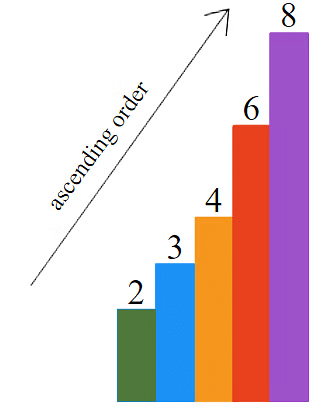Numbers Up to 20 - 2 Class 1 Worksheet Maths Chapter 11

Q1: Use the Correct Symbols
(i) 7 ___ 9
(ii) 15 ___ 12
(iii) 4 ___ 4
(iv) 10 ___ 18
(v) 14 ___ 6
Ans:
(i) 7 < 9
(ii) 15 > 12
(iii) 4 = 4
(iv) 10 < 18
(v) 14 > 6
Q2: Arrange the Numbers in Descending Order
(i) Arrange these numbers in descending order: 16, 3, 12, 8, 19
(ii) Arrange these numbers in descending order: 10, 2, 17, 6, 13
(iii) Arrange these numbers in descending order: 20, 11, 5, 1, 7
(iv) Arrange these numbers in descending order: 9, 15, 4, 14, 18
(v) Arrange these numbers in descending order: 2, 6, 13, 11, 7
Ans:
(i) 19, 16, 12, 8, 3
(ii) 17, 13, 10, 6, 2
(iii) 20, 11, 7, 5, 1
(iv) 18, 15, 14, 9, 4
(v) 13, 11, 7, 6, 2
Q3: Arrange the Numbers in Ascending Order
(i) Arrange these numbers in ascending order: 14, 1, 6, 19, 11
(ii) Arrange these numbers in ascending order: 5, 12, 18, 4, 9
(iii) Arrange these numbers in ascending order: 10, 2, 15, 3, 8
(iv) Arrange these numbers in ascending order: 16, 7, 13, 20, 17
(v) Arrange these numbers in ascending order: 6, 9, 1, 11, 4
Ans:
(i) 1, 6, 11, 14, 19
(ii) 4, 5, 9, 12, 18
(iii) 2, 3, 8, 10, 15
(iv) 7, 13, 16, 17, 20
(v) 1, 4, 6, 9, 11

Q4: Fill in the Correct Letters to Complete the Number Names
(i) 1 = O _ E
(ii) 5 = F _ V _
(iii) 12 = T _ E _ V _
(iv) 17 = S _ V _ N T_ _ N
(v) 20 = T _ _ N _ Y
Ans:
(i) 1 = ONE
(ii) 5 = FIVE
(iii) 12 = TWELVE
(iv) 17 = SEVENTEEN
(v) 20 = TWENTY
Q5: Statement Questions with Situations
(I) If you have 8 apples and your friend has 5 apples, how many apples do you both have together?
Ans: To find the total number of apples you both have together, simply add the number of apples you have to the number your friend has.
Total apples: 13
(ii) If you have 15 candies and you eat 3 of them, how many candies do you have left?
Ans: To find out how many candies you have left, subtract the number of candies you ate from the total number of candies you originally had.
15(original candies)−3(eaten candies)=12(candies left)
Candies left: 12
(iii) If you count from 1 to 10, what number comes after 7?
Ans: When counting in sequential order, the number that comes after 7 is 8.
Number after 7: 8
(iv) If you have 14 toys, and you give 6 toys to your friend, how many toys do you have left?
Ans: To find out how many toys you have left, subtract the number of toys you gave away from the total number of toys you had.
14(original toys)−6(given toys)=8(toys left)
Toys left: 8
(v) If you have 9 marbles, and your brother has 11 marbles, who has more marbles?
Ans: To determine who has more marbles, compare the number of marbles you have to the number your brother has.
- You have: 9 marbles
- Your brother has: 11 marbles
Since 11 is greater than 9, your brother has more marbles.
Brother has more marbles.
Q6: Write the Missing Numbers
(i) 1, 2, __, 4, 5(ii) __, 8, 9, 10, 11
(iii) 12, 13, 14, __, 16
(iv) 17, __, 19, 20
(v) 3, __, 5, 6
Ans:
(i) 1, 2, 3, 4, 5
(ii) 7, 8, 9, 10, 11
(iii) 12, 13, 14, 15, 16
(iv) 17, 18, 19, 20
(v) 3, 4, 5, 6
Q7: What Comes Before, Between, and After a Number?
(i) What comes before 9?
(ii) What comes between 14 and 16?
(iii) What comes after 19?
(iv) What comes before 5?
(v) What comes between 10 and 12?
Ans:
(i) Before 9 comes 8.
(ii) Between 14 and 16 comes 15.
(iii) After 19 comes 20.
(iv) Before 5 comes 4.
(v) Between 10 and 12 comes 11.
|
16 videos|135 docs|23 tests
|
FAQs on Numbers Up to 20 - 2 Class 1 Worksheet Maths Chapter 11
| 1. What are some strategies for teaching numbers up to 20 to Class 1 students? |  |
| 2. How can I help my Class 1 child develop a strong foundation in numbers up to 20? |  |
| 3. What are some common difficulties that Class 1 students may face when learning numbers up to 20? |  |
| 4. Are there any online resources or apps available to support the learning of numbers up to 20 for Class 1 students? |  |
| 5. How can I make learning numbers up to 20 fun and engaging for my Class 1 students? |  |
















